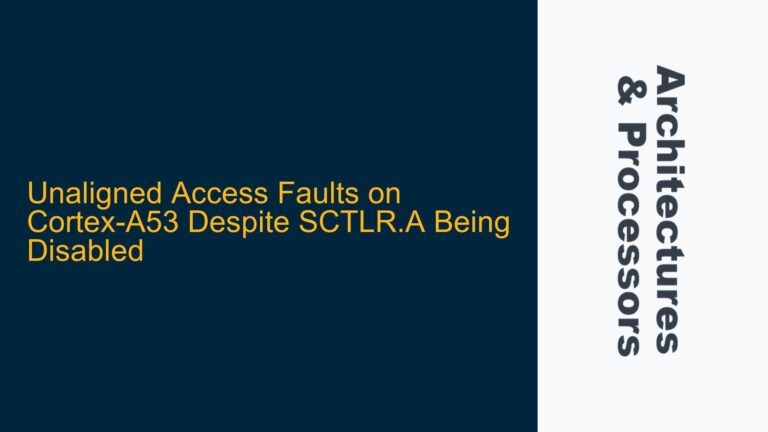VTOR Bit Allocation and Vector Table Address Constraints in Cortex-M7
The Vector Table Offset Register (VTOR) in ARM Cortex-M7 processors plays a critical role in defining the starting address of the vector table, which contains the initial stack pointer value and the exception handlers’ addresses. The VTOR register allows the vector table to be relocated to different memory regions, providing flexibility in system design. However, the bit allocation and address constraints of VTOR, particularly bits [31:30], have been a source of confusion due to documentation discrepancies and hardware implementation details.
In the Cortex-M7 architecture, VTOR is a 32-bit register where bits [31:7] define the offset of the vector table from the base address of the memory region. The lower 7 bits are reserved and must be zero, ensuring that the vector table is aligned to a 128-byte boundary. This alignment is necessary because the vector table consists of 32-bit entries, and the processor requires the table to be contiguous and properly aligned for efficient exception handling.
The confusion arises from the interpretation of bits [31:30] in VTOR. In some early Cortex-M3 processors (revisions r0p0 to r1p1), VTOR was limited to bits [29:7], meaning that the vector table could only be placed in the lower 1 GB of the address space (addresses 0x00000000 to 0x3FFFFFFF). This limitation was due to hardware design constraints in early implementations. However, in later Cortex-M processors, including Cortex-M4 and Cortex-M7, VTOR was extended to support bits [31:7], allowing the vector table to be placed anywhere in the 32-bit address space (addresses 0x00000000 to 0xFFFFFFFF).
Despite this extension, the documentation for Cortex-M7 processors initially failed to reflect this change, leading to misunderstandings about the permissible address range for the vector table. Specifically, the documentation incorrectly suggested that bits [31:30] were reserved or had special meaning, which is not the case in modern Cortex-M7 implementations. This documentation error has since been acknowledged and corrected, but it remains a point of confusion for developers working with Cortex-M7 processors.
Implications of VTOR Bit Allocation on Vector Table Placement
The allocation of bits in VTOR has significant implications for the placement of the vector table in memory. In systems where the vector table is located in flash memory, the address of the flash region must be compatible with the VTOR bit allocation. For example, if the flash memory is located at address 0x60000000, bits [31:30] of the VTOR register will be set to 0b01. In early Cortex-M3 processors, this address would be invalid because VTOR was limited to bits [29:7]. However, in Cortex-M7 processors, this address is valid because VTOR supports bits [31:7].
The ability to place the vector table in higher memory regions is particularly useful in systems with multiple memory banks or external memory interfaces. For instance, in a system with both internal flash and external QSPI flash, the vector table can be placed in either memory region depending on the system’s requirements. This flexibility allows developers to optimize system performance and memory usage based on the specific application.
However, developers must be aware of the alignment requirements for the vector table. The lower 7 bits of VTOR must be zero, meaning that the vector table must be aligned to a 128-byte boundary. Failure to meet this requirement can result in undefined behavior or system crashes. Additionally, the size of the vector table must be considered when selecting its location. The vector table typically contains the initial stack pointer value and the addresses of exception handlers, and its size depends on the number of exceptions supported by the processor.
Correcting VTOR Configuration and Ensuring Proper Vector Table Placement
To ensure proper vector table placement in Cortex-M7 processors, developers must follow a systematic approach to configuring VTOR and verifying its settings. The first step is to determine the base address of the memory region where the vector table will be located. This address must be aligned to a 128-byte boundary, and bits [31:7] of the address must be compatible with the VTOR bit allocation.
Once the base address is determined, the VTOR register can be configured by writing the address to the VTOR register. This is typically done during system initialization, before any exceptions are enabled. The following code snippet demonstrates how to configure VTOR in a Cortex-M7 system:
#include <stdint.h>
#define VTOR_REGISTER (*(volatile uint32_t *)0xE000ED08)
void configure_vtor(uint32_t vector_table_address) {
// Ensure the address is aligned to a 128-byte boundary
if ((vector_table_address & 0x7F) != 0) {
// Handle alignment error
return;
}
// Write the address to the VTOR register
VTOR_REGISTER = vector_table_address;
}
After configuring VTOR, developers should verify that the vector table is correctly placed and accessible. This can be done by reading the VTOR register and comparing it to the expected address. Additionally, the contents of the vector table should be checked to ensure that the initial stack pointer value and exception handler addresses are correct.
In systems where the vector table is located in flash memory, developers must also consider the flash memory’s characteristics, such as access time and wait states. If the flash memory has a long access time, it may be necessary to enable flash acceleration features or use a cache to improve system performance. In some cases, it may be beneficial to copy the vector table to RAM during system initialization and configure VTOR to point to the RAM copy. This approach can reduce exception latency and improve system responsiveness.
In conclusion, understanding the bit allocation and address constraints of VTOR is essential for proper vector table placement in Cortex-M7 processors. By following the guidelines outlined in this post, developers can ensure that their systems are configured correctly and avoid common pitfalls related to VTOR configuration.






